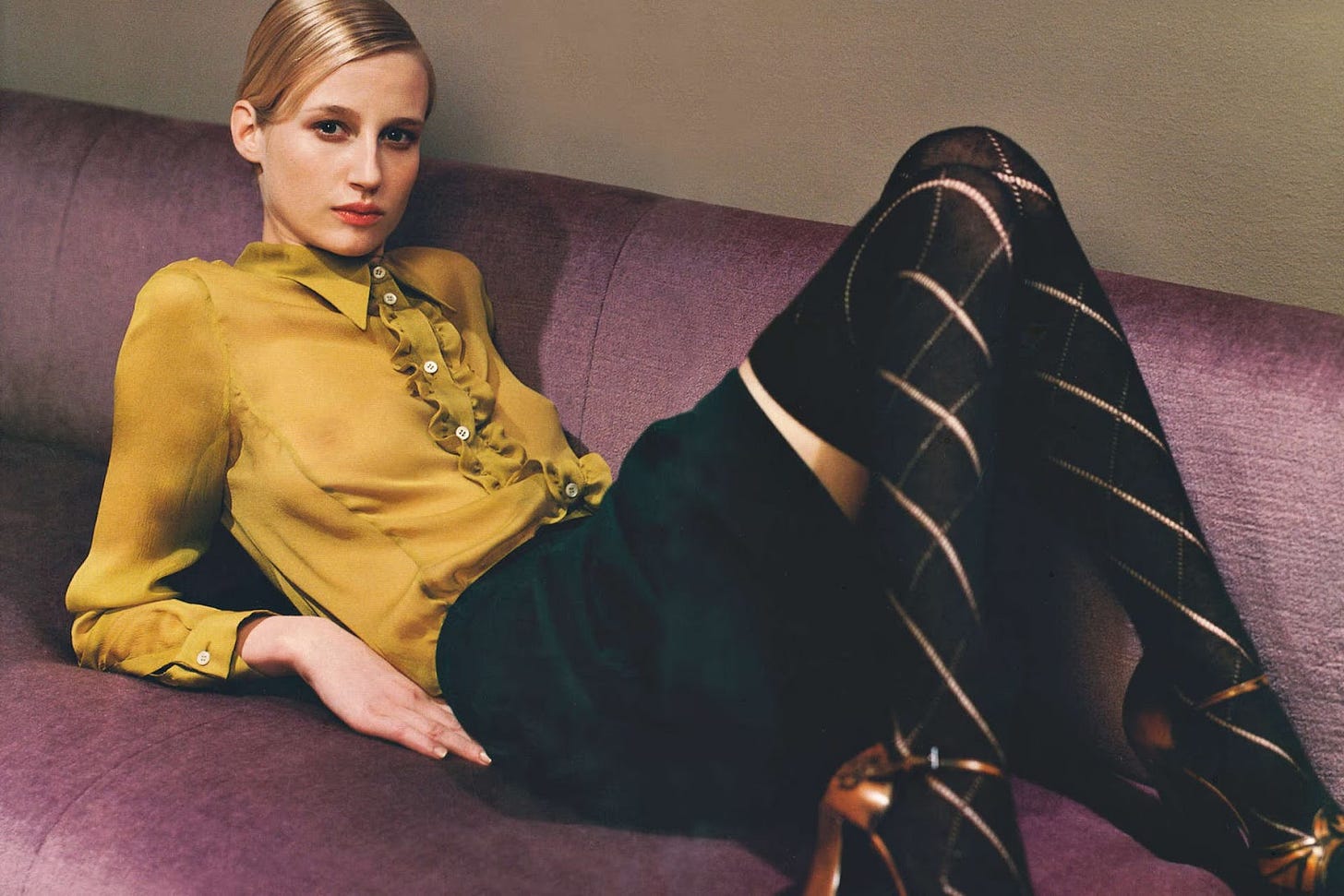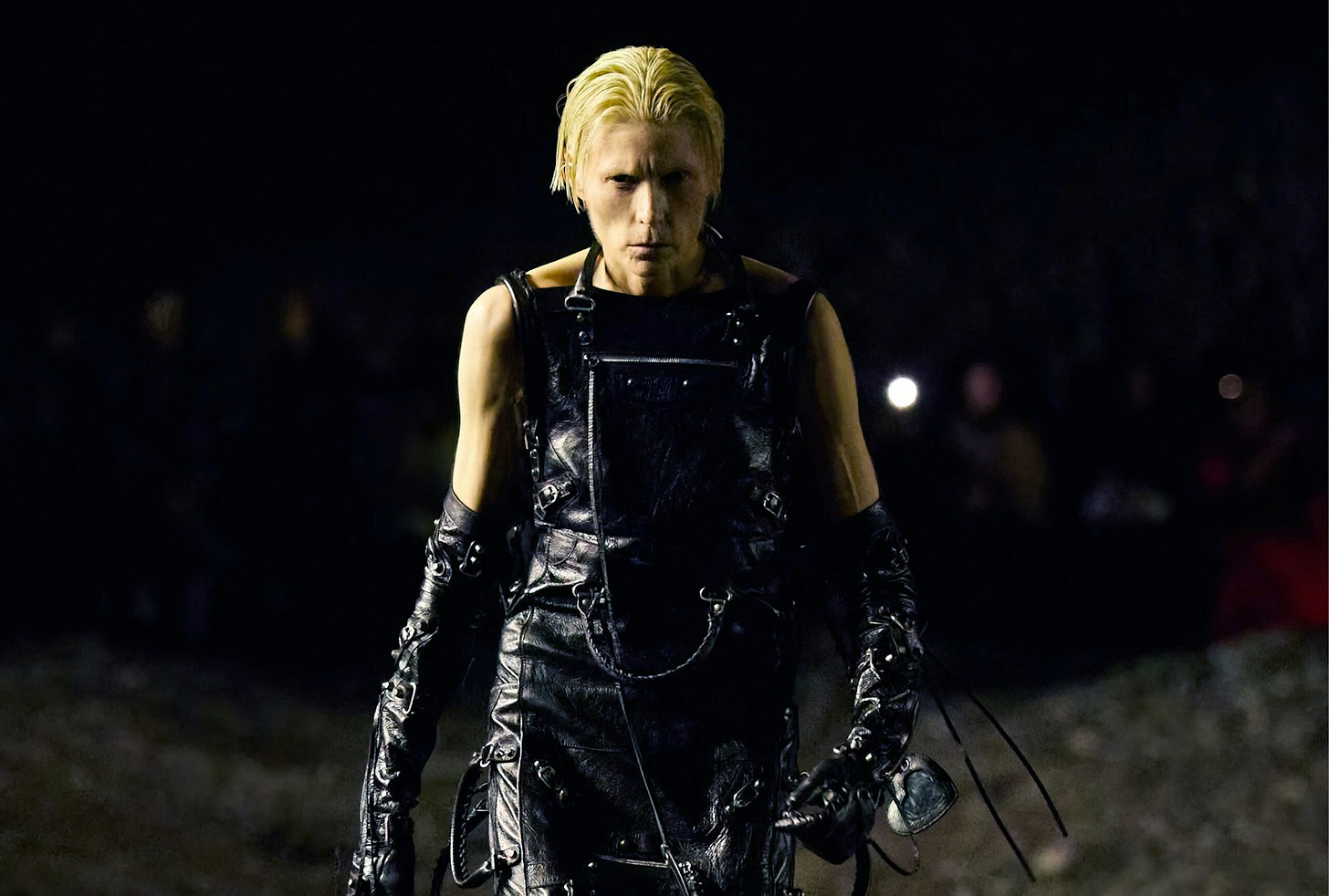Over the past decade, an unconventional fashion trend has emerged: a rejection of traditional, polished beauty, favoring the ugly, the strange, and the distressed. In an era dominated by algorithmically generated trends like “coquette”, “clean girl aesthetic”, and “quiet luxury”, choosing looks that could be deemed visually unappealing is becoming a deliberate act of rebellion. This shift highlights an emerging emphasis on individuality and self-expression over conformity to mainstream standards of beauty.
Some fashion designers have embraced ugliness as a foundational element of their aesthetic. Miuccia Prada, for instance, has long challenged conventional notions of beauty through her work. In his 2014 essay, Miuccia Prada: Master of “Ugly”, fashion journalist Alexander Fury recalled the designer’s groundbreaking Spring/Summer 1996 collection, a pivotal moment for the brand.
Departing sharply from the serene minimalism of previous seasons, Prada turned to clashing color schemes, outdated patterns, and what Fury called “Miuccia Sludge”: a signature shade of green blending the tones of mold and slime. The collection, famously dubbed “Ugly Chic”, rejected polished ideals in favor of chaos, subverting traditional fashion rules and embracing something raw and unrefined.
Prada’s radical approach was an invitation to reconsider beauty standards: the aim was not to make the unappealing beautiful but to make the audience question what beauty and good taste are. By introducing elements of the ordinary into luxury, Prada reshaped our expectations, asking us to reconsider why certain designs are deemed beautiful in the first place.
Similarly, designers like Martin Margiela, Rei Kawakubo, and Yohji Yamamoto have long used deconstructivism to challenge traditional beauty standards. These designers intentionally distort proportions and embrace imperfection, asymmetry, and non-functionality. They leave seams exposed, tailoring uneven, and fabric frayed or repurposed. The result is fashion that is not about enhancement but about self-expression.
By rejecting the idea that clothes should conform to idealised body types or enhance beauty, these designers create something radically different: garments that speak to the individuality of the wearer, suggesting that beauty is something that emerges from the unconventional and the imperfect, rather than an absolute concept.
Balenciaga, under the direction of Demna Gvasalia, elevated ugliness to new extremes and unprecedented levels of global virality, though in a markedly different way from his predecessors. The brand’s "mud show" and destroyed high-top sneakers (priced at $1850) sparked controversy. Some saw the shoes as a critique of consumerism, others as a clever marketing move, and a social experiment. The question remains: how much of Balenciaga’s project was a genuine challenge to society and fashion’s inherent elitism, and how much was a reflection of the very capitalism it aimed to critique?
The brand’s ability to provoke this debate highlights the complexity of the ugly trend. What starts as a challenge to beauty norms often becomes commodified, as the shock factor fades and these once-rebellious designs gain viral popularity. Thus, a process of constant evolution is essential to the ugly aesthetic’s survival.
This ongoing evolution of ugliness in fashion can also be seen in more recent trends, such as Charli XCX’s brat summer. With acid green as a common symbol with Prada, the brat aesthetic deliberately rejects the polished, pristine aesthetics popularized by social media. Instead, she embraces a raw, chaotic expression that aligns with a broader cultural shift toward freedom and individuality.
Charli XCX, speaking to BBC, described a brat as someone "honest, blunt, and a little bit volatile," a girl who "has a breakdown, but kind of like parties through it." This brat energy rejects the societal pressure to be calm and collected, offering a new space for authentic self-expression. In her music video for 360, Charli XCX celebrates the unique, unconventional aesthetics of “hot Internet girls” like Julia Fox and Gabbriette, known for setting trends by embracing weirdness, imperfection, and defying industry standards.
This new wave of ugly fashion, however, isn’t industry-driven. Instead, it’s rooted in personal creativity and expression. Charli XCX’s fanbase, for example, embraces second-hand clothing and repurposed garments, celebrating individuality over mass consumerism. The growing popularity of this approach demonstrates that, while the fashion industry can help amplify these movements, the true power behind the ugly trend lies in the hands of individuals expressing themselves freely and authentically.
The ugly trend continues to live on and evolve through Lady Gaga’s Mayhem era, as shown by her distressed final look at Coachella. In her most recent work, Lady Gaga delves into the darker corners of the self, confronting her inner demons and coming to terms with the parts of herself that are usually hidden. This focus on internal darkness mirrors the broader cultural shift toward accepting what is traditionally deemed ugly in both the external world and within ourselves. By embracing the grotesque, we are invited to reflect on, confront, and ultimately find new solutions to the ugly aspects of our lives and the world around us.
Ultimately, this evolution of ugly fashion represents a rejection of the narrow, commercially driven definitions of beauty. From Miuccia Prada’s groundbreaking 1996 collection to Charli XCX’s brat aesthetic and Lady Gaga’s exploration of darkness, we are witnessing a shift in how beauty is defined. No longer confined to the glossy standards of the past, beauty is now found in the imperfect, the strange, and the uncomfortable. This new form of beauty isn’t just about fashion: it’s about reclaiming autonomy over how we define ourselves and the world around us.










Martin Margiela invented the true reality of this. In one way or another, it's been going on since the late 70's: Punk was this. None of this is new, at least not to those of us mature enough to have lived through it.
I thought this was so interesting and well written! One of the unfortunate things about the rising trend of "embracing the ugly" that I still see as very pertinent today is that it's reserved for already attractive people. I feel that dressing 'ugly' or disobeying beauty aesthetics is only permissible if you're skinny enough or conventionally attractive enough, like a certain level of beauty is a prerequisite to rebelling against the beauty standards. I would love to know if you agree with this take, I just feel like we haven't gotten to the point yet where everyone is 'allowed' to test the boundaries of 'beauty'.